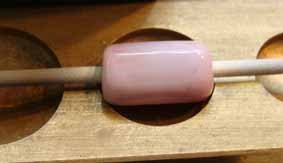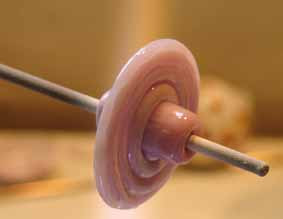Dragged Dots
When in chat on Lampwork Etc this morning, I was asked how I get my dots to behave and evenly spaced around the bead. This is just a quickie tutorial that I did on how I get evenly spaced dots. For fun I also show you how to drag dots ...
1. Make your bead - I made a 20 mm hole to hole round bead, but you can choose any shape you like.

2. I start off with getting the correct distance between my dots by normally adding a raised dot the same colour as the base bead. The black would have been difficult to see in the pictures, so I did them in white. Please excuse the reflection of me and my overhead light in a lot of these pictures!
Here is the first raised dot. Do not squash the dot into the bead, and make sure that your bead is not glowing hot when placing the said dot. I will tell you in a minute or so why you need to leave the dot raised ...

3. Place a dot on the exact opposite side of the first dot. I normally eyeball the bead from the one bead hole side while I place the blob of glass on it, praying like mad that I placed it in the centre of the bead. NOW, if I placed that dot skew or in the wrong place, it is easy to flick it off the bead using a blade or other tool, because it is raised ... Once your are happy that it is in the correct place, you can give it some more heat, to prevent it from shocking off while you work on the other placements. Easy, huh?
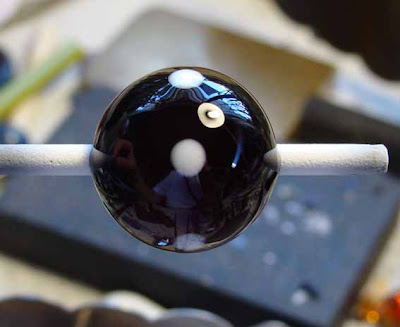
4. Here I have added all my dots, and made sure that they are all equally spaced. Normally I melt these dots in till there is only a slight bump visible. To prevent dots from migrating and forming little groups of annoying dots, I have found that if I twirl my bead in both directions (i.e. forwards and backwards spin) I have less migration taking place. Some say to heat each dot individually, other schools say heat them all. I found the forward/backward motion really make them little buggers stay in place ...

5. (If I wanted to start adding decoration the the centre of the bead, I will use the empty space between the base coloured dots as my placement area. Just add your dots exactly in the centre of each space ...)
Now it is time to place my other dots. I will come back to these centre dots later on ... I start with the centre petal dot for each dragged flower/Fleur De Lis pattern. Add a drop of glass to dots that is not the same size ...
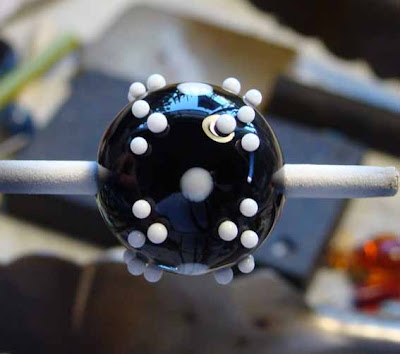
6. Now it is time for the rest of the dots/leaves. With the Fleur De Lis pattern I have found that you really need to add the dots in a perfect triangle pattern. If the side petals is to far away from the centre dots, you will really battle to catch them when you drag the glass. For most of these dots I have placed only groups of 3, but when you want to add another row, place them exactly below the first group of 2 dots.

7. Melt them all in, and regain a round shape of your bead. Again – use the forward/backward turning of your mandrel to make sure the dots does not migrate around the bead ...
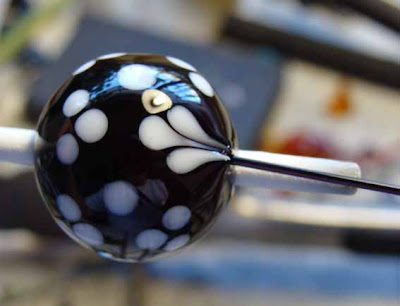
8. Take a thin stringer of your base colour, spot heat the entire area of dots and the area where you want to drag your dots, touch the cool stringer to the black space between the 3 dots, as close as possible to the centre dot’s edge, and lightly drag the glass. Try not to push the stringer into the bead. (That takes a bit of practice to get right.) I do not always get all 3 dots to move, and when this happens, I just heat the area again, and drag it. No glass is gonna put ears on me!
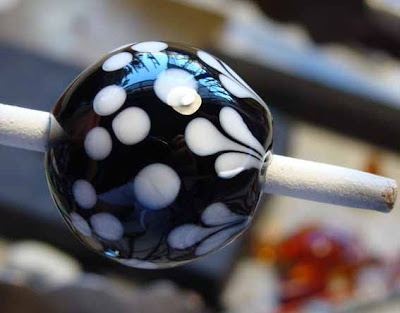
9. Once I have finished decorating the one side, I move to the other side and drag them buggers! We will correct the wonkiness of the bead soon ...

10. Both sides done, so I added more white to the centre dots, to make them a bit bigger, and added dots of a transparent colour.
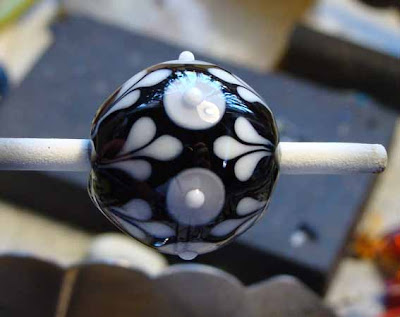
11. And some more white dots ... OK, I love dots, lol
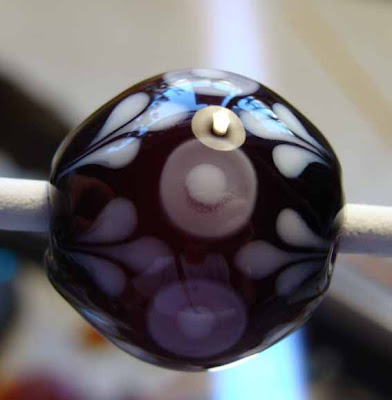
12. So here is the bead, I am done with my decorations, but oh boy, it is seriously wonky. You can just twill it in the flame until your pattern distorts, or use my approach ...

13. First I just heat up the one side. Remember to turn the mandrel to both sides, otherwise you glass will start to float on the mandrel, and your pattern will become distorted. Once you are happy with the one side, let the bead cool down, and focus heat on the other side.

14. Normally the heat from the sides is enough to shift the glass a bit to create a nice neat round bead, but if you added a lot of decorations to the centre, you might want to focus some heat to the centre too. Admire bead while you continue twirling it around, and when it is stiff enough, pop it into the kiln!



